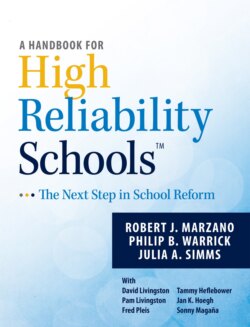Читать книгу A Handbook for High Reliability Schools - Robert J Marzano - Страница 11
На сайте Литреса книга снята с продажи.
Monitoring Performance for Continuous Improvement
ОглавлениеOnce a school has met the criterion scores for a level’s lagging indicators, it is considered to have achieved high reliability status for that level. However, being a high reliability school at a given level involves more than meeting criterion scores for lagging indicators. Recall from the previous discussion of high reliability organizations that implementing processes and procedures to prevent problems is only part of what they do. High reliability organizations also constantly monitor critical factors, looking for changes in data that indicate the presence of problems.
Similarly, high reliability schools monitor critical factors and immediately take action to contain and resolve the negative effects of problems as quickly as possible. Even after a school has achieved high reliability status for a specific level, its leaders continue to collect and analyze data related to leading and lagging indicators to ensure that the expectations of that level are continuously met over time. In the event that data for a specific indicator cease to meet expectations, school leaders intervene to identify the problem, minimize any negative effects of the problem, and either strengthen existing processes and procedures or implement new ones to fix the current problem and prevent future ones.
Constantly monitoring critical factors for problems requires continual data collection and observation. Consider an organization with very little tolerance for errors: the U.S. Navy. Particularly, consider an aircraft carrier, a ship from which fighter jets, helicopters, and other aircraft take off and land. The number of potential errors in such an environment is mind-boggling. For example, even small debris—like a pebble or scrap of cloth—on the flight deck can cause catastrophic problems for the finely tuned engines and other sensitive systems of naval aircraft. Therefore, the U.S. Navy implements systematic FOD walks. FOD stands for “foreign objects and debris,” and during a FOD walk, personnel on the aircraft carrier walk along the deck shoulder to shoulder, picking up anything that they find. Such procedures occur multiple times each day. Figure I.1 shows a FOD walk being conducted on board an aircraft carrier.
Source: U.S. Navy, 2005. In public domain.
Figure I.1: FOD walk being conducted on board an aircraft carrier.
As seen here, FOD walks require all members of a ship’s crew to work together to identify and resolve potential problems.
Consider another example of the power of continual data collection and monitoring. Studies show that daily weigh-ins help individuals lose weight and keep it off (for example, see Linde, Jeffery, French, Pronk, & Boyle, 2005, and Wing, Tate, Gorin, Raynor, & Fava, 2006). Each time someone steps on the scale, that person collects a data point that shows whether he or she is moving toward or away from the target. If data show that he or she is not moving toward or maintaining the goal, he or she can take steps to minimize the impact of errors (such as eating less at meals or snacking less frequently).
In the same way that aircraft carrier crews walk along the flight deck or a dieter steps on the scale every day, so too must teachers and administrators monitor the reliability of their school even after they have achieved high reliability status at a specific level. Such work can be accomplished through quick data, problem prevention and celebration of success, and level-appropriate data collection.
